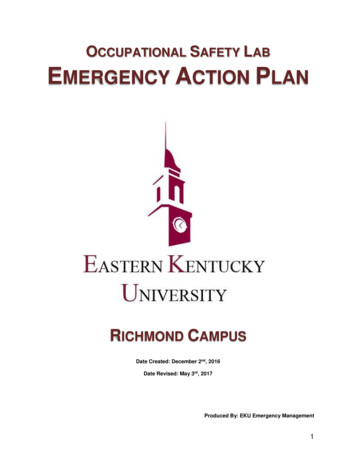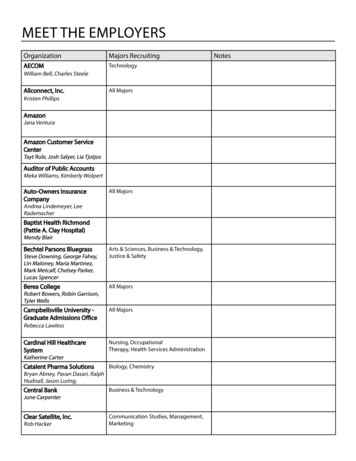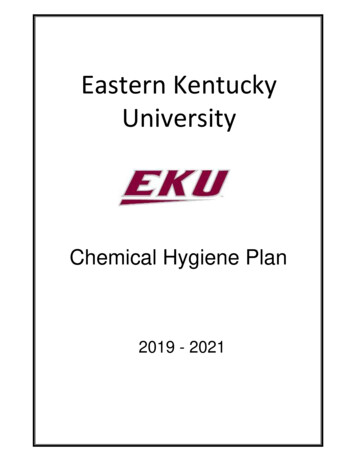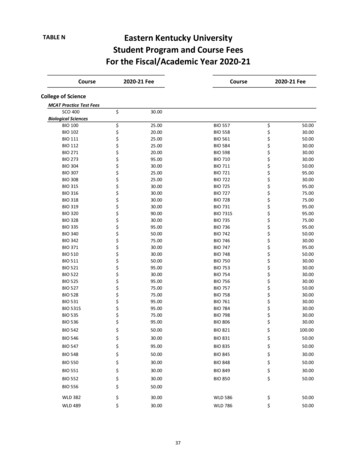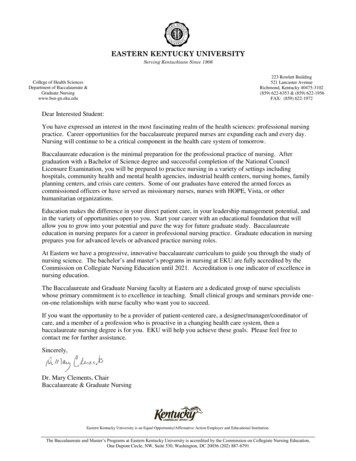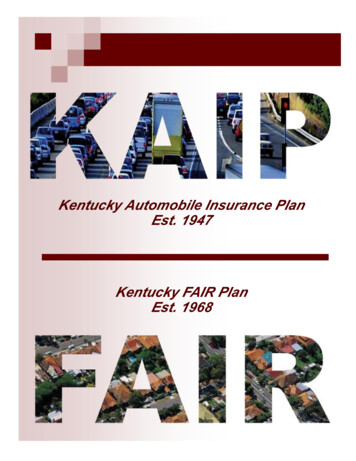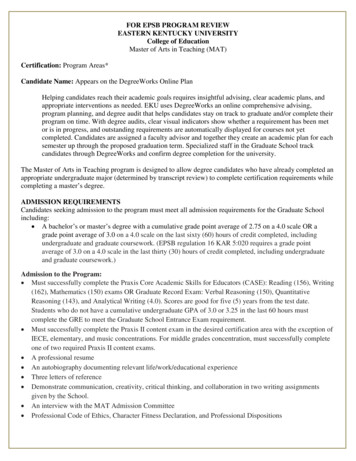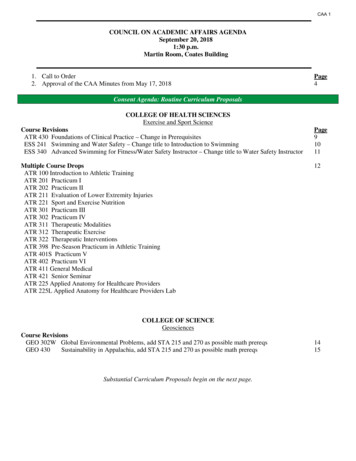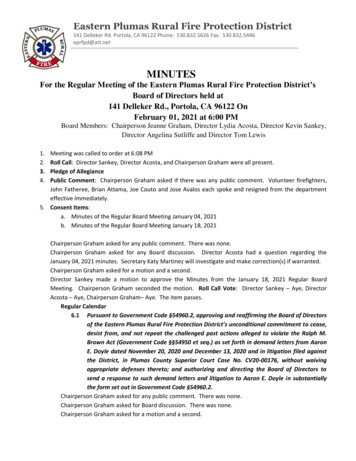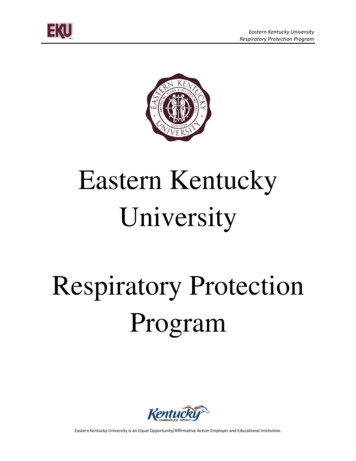
Transcription
Eastern KentuckyUniversityRespiratory ProtectionProgram
Eastern Kentucky UniversityRespiratory Protection ProgramTable of ContentsSectionPage1.02.03.04.05.06.07.0Purpose and Scope .1Policy .1Codes and Regulations.1Responsibilities .1Purchase of Equipment .2Respirator Selection .2Respiratory Hazards .37.1. IDLH Atmospheres .37.2. Non-IDLH Atmospheres .37.3. Assigned Protection Factors.47.4. Characteristics, Capabilities, and Limitations of Respirators .68.0 Medical Evaluations.68.1. Medical Procedures .68.2. Medical Evaluation .78.3. Written Recommendation .88.4. Medical Evaluation Frequency .89.0 Medical Records .810.0Fit-Testing Requirements .910.1.Fit-Test Procedures.910.2.Fit-Test Frequency .1010.3.Facepiece Seal Protection.1010.4.Fit-Test Records .1111.0Respirator Effectiveness .1112.0IDLH Atmospheres or Interior Structural Firefighting .1112.1.IDLH Procedures.1112.2.Interior Structural Firefighting .1213.0Maintenance and Care .1213.1.Cleaning .1213.2.Storage.1313.3.Inspection .1313.4.Certification for Emergency Respirators .1313.5.Repairs.1413.6.Breathing Air Quality .1413.7.Maintenance and Care Records .1514.0Training .1514.1.Training Program .1514.2.Training Frequency .1514.3.Training Records .1515.0Work Area Surveillance and Air Monitoring .1616.0Program Evaluation .16Created: 5/18/09Revised: 7/1/09Page iNote: If the EKU symbolis not maroon,this document is uncontrolled.
Eastern Kentucky UniversityRespiratory Protection ProgramTable of ContentsAppendices:A – Fit Testing ProceduresB – User Seal Check ProceduresC – Respiratory QuestionnaireD – Voluntary Use of RespiratorsE – Training RecordF – Manufacturers RecommendationsG – Canister and Cartridge Change Schedule DataH – OSHA 1910.134I – American National Standards Institute (ANSI) Z88 SeriesJ – NFPA 1404Created: 5/18/09Revised: 7/1/09Page iiNote: If the EKU symbolis not maroon,this document is uncontrolled.
Eastern Kentucky UniversityRespiratory Protection Program1.0 Purpose and ScopeThe Eastern Kentucky University Respiratory Protection Program (RPP) establishes theminimum requirements for employees who must use respirators. The RPP outlinesgovernment-wide procedures according to the Occupational Safety and HealthAdministration (OSHA) Respiratory Protection Standard 29CFR1910.134. The purpose ofthis regulation is to control occupational diseases caused by breathing contaminated air. ThisRPP covers the proper selection and use of respirators, medical evaluations, fit-testing,interior structural firefighting, maintenance and care, training, monitoring, and programevaluation for respiratory protective equipment.2.0 PolicyEvery consideration will be given to the use of engineering controls to eliminate or reduceexposure to respiratory hazards. However, when feasible engineering controls are noteffective in controlling toxic substances, each division will provide applicable and suitablerespiratory protective equipment to the employee at no charge.3.0 Codes and RegulationsOccupational Safety and Health Administration 29CFR1910.134NFPA 1404 Standard for Fire Service Respiratory ProtectionANSI Z88 Series4.0 ResponsibilitiesAll Employees – All employees are charged with the responsibility to assist in and supportthe implementation of this program and enforcement of its use.Authorized Employees – Employees who will be required to don and doff respirators as partof their job.Volunteers – All volunteers are charged with the responsibility to assist in and support theimplementation of this program and enforcement of its use.Program Administrators – The Eastern Kentucky University Program Administrators arelisted below by title. These administrators are responsible to oversee and evaluate therespiratory protection program. The Program Administrators will be trained and hold anaccountable position for the management of this program. Specifically, the administrator’sduties are as follows:Environmental Health and Safety Director – The Director of EH&S is responsible forthe creation and maintenance of this program.Facilities Services – Each affected department Director is responsible forimplementation and enforcement of this program throughout their respective area(s).These areas include the Heat Plant, Paint Shop, and Pesticide Department.Fire Extinguisher Laboratory Lab Coordinator - is responsible for the implementationand enforcement of this program throughout the fire extinguisher lab and any live firescene of which they have control.Fire and Safety Engineering Technology Department Chair - is responsible for theimplementation and enforcement of this program the Eastern Kentucky University FireSafety Engineering Technology Program for professors and staff actively participating inlive fire demonstrations and similar activities requiring respiratory protection.Police Chief – The Police Chief is responsible for the implementation and enforcementof this program throughout the Police Department and within the respective specializedprograms.Created: 5/18/09Revised: 7/1/09Page 1 of 16Note: If the EKU symbolis not maroon,this document is uncontrolled.
Eastern Kentucky UniversityRespiratory Protection ProgramStudent Health Services Staff Physician – is responsible for the implementation andenforcement of this program in the Student health Services Department.When evaluations reveal a failure to follow this program, appropriate steps, includingdisciplinary actions, will be taken as required by the Eastern Kentucky UniversityDisciplinary policy.5.0 Purchase of EquipmentIn order to comply with OSHA’s Standard on Respiratory Protection, all respiratoryprotective equipment purchased will be certified by the National Institute for OccupationalSafety and Health (NIOSH) and will be used in compliance with the conditions of itscertification. Each department will be responsible for the cost incurred in implementing thisprogram. Equipment will be provided to Eastern Kentucky University employees free ofcharge.The Chief, Director or designated program administrator of each respective department/areawill be responsible for ensuring all required respiratory protection and related items arepurchased.6.0 Respirator SelectionThe respiratory protective devices must be certified by NIOSH per 42 CFR Part 84Each employee shall be given the opportunity to select a respirator which provides the mostcomfortable fit while not jeopardizing safety. Each authorized employee will be given atleast two (2) styles of respirators to choose from. For safety reasons, Eastern KentuckyUniversity has determined that Scott brand respirators will be used for firefighting operations.All respirators selected will be certified by the National Institute for Occupational Safety andHealth (NIOSH) and will be used in compliance with the conditions of its certification.In selecting the correct respirator for a given circumstance, the respiratory hazard, IDLHatmospheres, assigned protection factors, and respirator limitations will be considered.Due to the fact that Eastern Kentucky University cannot identify or reasonably estimatefirefighter exposures, these users are considered to be in IDLH atmospheres unless otherwisedetermined.If an employee wears corrective lenses, Eastern Kentucky University will purchaserespiratory protection that allows the employee to use the lenses. Full-face respiratorscapable of accepting an insert for corrective lenses will be available. A list of approved respirators and filters is located in Appendix E, “Respirator andFilter Selection.”It is the policy of the Eastern Kentucky University that there will be no voluntary use ofrespirators in the workplace. For reference, see 1910.134(c)(2).Created: 5/18/09Revised: 7/1/09Page 2 of 16Note: If the EKU symbolis not maroon,this document is uncontrolled.
Eastern Kentucky UniversityRespiratory Protection Program7.0 Respiratory HazardsNature of the Hazard – The nature of the hazard that requires respiratory protection must beidentified in order to protect the worker. Oxygen deficiency, properties of the toxic orharmful substance, effects on the body, concentrations or the toxic substance, and thePermissible Exposure Limits (PEL’s) will be considered.Workplace Factors – Workplace factors will be considered when selecting a respirator.These factors include the operation or task details; physical hazards such as temperature,humidity and length of exposure; and the degree of knowledge of the substance(s) thatworkers will be exposed.Employee Exposure – A reasonable estimate of the employee’s anticipated exposure mustbe documented. This includes monitoring data or other objective studies and/or informationthat will give an approximate exposure for the task. The physical state and chemical form ofthe hazard (if known) must be included in this documentation. Some operations will haveunknown exposures (i.e. firefighting, police response to a drug lab, etc.) that will be treated asIDLH atmospheres due to the hazard of the environment.7.1. IDLH AtmospheresFor Immediately Dangerous to Life and Health (IDLH) atmospheres, the most protectiveand reliable respiratory protection is a pressure demand Self Contained BreathingApparatus (SCBA) with at least a 30-minute service life or combination pressure demandsupplied air respirator with auxiliary self contained air supply. Either of these systemsmust be used for any IDLH environment. All oxygen deficient atmospheres are IDLHunless they are within the ranges in Table II.Altitude in Feet1Less than 3,0013,001 – 4,0004,001 – 5,0005,001 – 6,0006,001 – 7,0007,001 – 8,0001Table IIOxygen deficient atmosphere for which theemployer may rely on atmosphere-supplyingrespirators16.0 – 19.516.4 – 19.517.1 – 19.517.8 – 19.518.5 – 19.519.3 – 19.5Above 8,000 feet the exception does not apply. Oxygen enriched breathing air must be supplied above 14,000 ft.Table II Note – The exception for IDLH use respirator: if the employer demonstrates thatthe oxygen concentration can be maintained within the ranges in table II, then anappropriate atmosphere supplying respirator may be used.7.2. Non-IDLH AtmospheresRespirators must be selected by their ability to reduce employee exposure therebyprotecting the employee from the particular contaminant(s) in routine job tasks and inreasonably foreseeable emergency situations.Gas or Vapor Atmospheres – The respirator must protect against breakthrough whenexposed to a gas or vapor. This must be guaranteed by implementing a replacementschedule for cartridges and canisters or changing them according to the end-of-serviceCreated: 5/18/09Revised: 7/1/09Page 3 of 16Note: If the EKU symbolis not maroon,this document is uncontrolled.
Eastern Kentucky UniversityRespiratory Protection Programlife indicator (ESLI). The method of using the odor threshold (changing the cartridgewhen the contaminant is detected by smell) or other warning properties cannot be used.Particulate Atmospheres – Selection for protection against particulates must be an airpurifying respirator used with a High Efficiency Particulate Air (HEPA) filter or a filtercertified under 42 CFR Part 84 or a respirator with supplied air. The HEPA filter must be99.7% efficient in removing monodisperse particles of 0.3 micrometers in diameter.NIOSH Color Coding System for Air-Purifying Respirators and NIOSH Filter ClassesColorCartridges for Air-Purifying Respirators –Negative PressureBlackOrganic Vapors (OV)Black (paint)OV, Paints, Lacquers & Enamels (no urethaneor diisocyanate paints)ChartreusePesticidesGreenAmmonia & MethylamineMagentaAsbestos, Dusts, Fumes and MistsMagenta/BlackOV, Dusts, Mists and AsbestosMagenta/YellowOV, chlorine, Formaldehyde, HydrogenChloride, Sulfur Dioxide, Dusts, Fumes, Mists,Raidonuclides & AsbestosOrangeMercuryYellowOV, Acid Gas, Formaldehyde, Sulfur DioxideNIOSH Certified Filtering FacepiecesFilter and Efficiencies (%)N95, N99, N100 (99.97%)R95, R99, R100 (99.97%)P95, P99, P100 (99.97%)Filtering Facepiece UseNot resistant to oil; for particulates and non oilbased aerosolsResistant to oil (change every 8-hour shift); forparticulates and oil-based aerosolsOil proof; for particulates and oil-basedaerosols7.3. Assigned Protection Factors (APF)The amount of protection the respirator can give is dependent upon the seal of thefacepiece to he face, leakage around the valves, and leakage through or around cartridgesor canisters. Through NIOSH studies, statistical numbers were derived for the variousmodels of each kind of respirator. At least 95% of the population had fit factors equal toor greater than the assigned protection factor for that respirator. Fit factor equals theconcentration of a contaminant outside the mask divided by the concentration inside themask. EKU will use the assigned protection factors listed in the table below to select arespirator that meets or exceeds the required level of employee protection. When using acombination respirator (e.g., airline respirators with an air-purifying filter), EKU willensure that the assigned protection factor is appropriate to the mode of operation in whichthe respirator is being used.Created: 5/18/09Revised: 7/1/09Page 4 of 16Note: If the EKU symbolis not maroon,this document is uncontrolled.
Eastern Kentucky UniversityRespiratory Protection ProgramMaximum Use Concentration (MUC)EKU will select respirators for its’ employees use that maintains the employee's exposureto the hazardous substance, when measured outside the respirator, at or below the MUC.EKU will not apply MUCs to conditions that are immediately dangerous to life or health(IDLH); instead, SCBA’s will be used for these conditions.All respirators and associated filters will be selected based on the chemical state andphysical form of the contaminant(s) present in the work environment for which there isan exposure. In protecting against gases and vapors, EKU will provide either anatmosphere-supplying respirator or an air-purifying respirator, provided that: therespirator is equipped with an end-of-service-life indicator (ESLI) certified by NIOSH forthe contaminant; or if there is no ESLI appropriate for conditions in the workplace, achange schedule for canisters and cartridges will be utilized that is based on objectiveinformation or data that will ensure that canisters and cartridges are changed before theend of their service life. EKU will describe in the respirator program the information anddata relied upon and the basis for the canister and cartridge change schedule and the basisfor reliance on the data (See Appendix G).For protection against particulates, the employees will be provided either: anatmosphere-supplying respirator; or an air-purifying respirator equipped with a filtercertified by NIOSH under 30 CFR part 11 as a high efficiency particulate air (HEPA)filter, or an air-purifying respirator equipped with a filter certified for particulates byNIOSH under 42 CFR part 84; or for contaminants consisting primarily of particles withmass median aerodynamic diameters (MMAD) of at least 2 micrometers, an air-purifyingrespirator equipped with any filter certified for particulates by NIOSH.1 2Type of respirator ,Assigned Protection Factors5Quarter Half maskFullmaskfacepieceLoosefittingfacepiece50 . .1,000 425/1,00025Helmet/hood31. Air-Purifying Respirator5102. Powered Air-Purifying Respirator.50(PAPR)3. Supplied-Air Respirator (SAR) orAirline Respirator Demand mode.1050 . . Continuous flow mode.501,000 425/1,00025 Pressure-demand or other positive.501,000 . .pressure mode4. Self-Contained Breathing Apparatus(SCBA) Demand mode.105050 . Pressure-demand or other positive. .10,00010,000 .pressure mode (e.g., open/closed circuit)Notes:1Employers may select respirators assigned for use in higher workplace concentrations of a hazardousCreated: 5/18/09Revised: 7/1/09Page 5 of 16Note: If the EKU symbolis not maroon,this document is uncontrolled.
Eastern Kentucky UniversityRespiratory Protection Programsubstance for use at lower concentrations of that substance, or when required respirator use isindependent of concentration.2The assigned protection factors in Table 1 are only effective when the employer implements acontinuing, effective respirator program as required by this section (29 CFR 1910.134), includingtraining, fit testing, maintenance, and use requirements.3This APF ca
Occupational Safety and Health Administration 29CFR1910.134 NFPA 1404 Standard for Fire Service Respiratory Protection . For safety reasons, Eastern Kentucky University has determined that Scott brand respirators will be used for firefighting operations. All respirators selected will be certified by the

